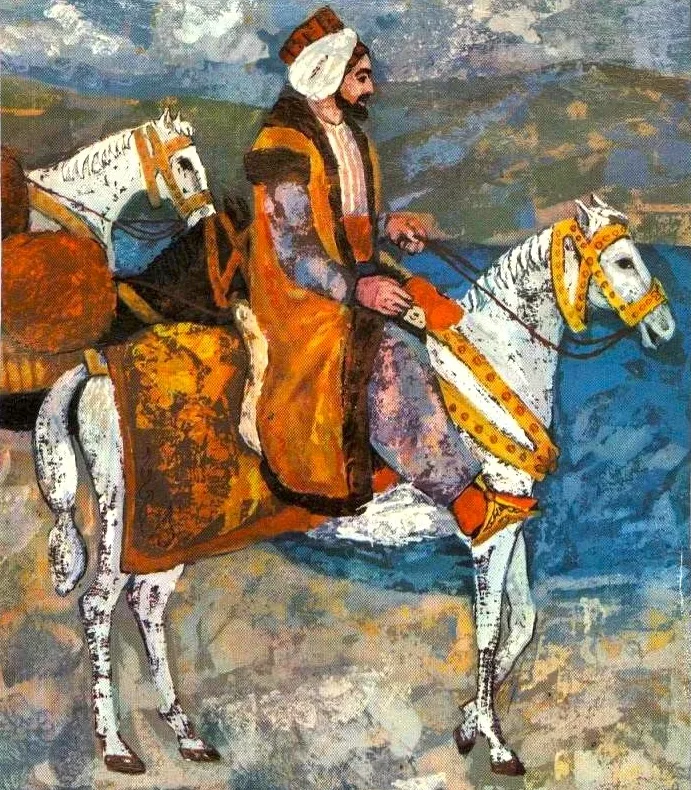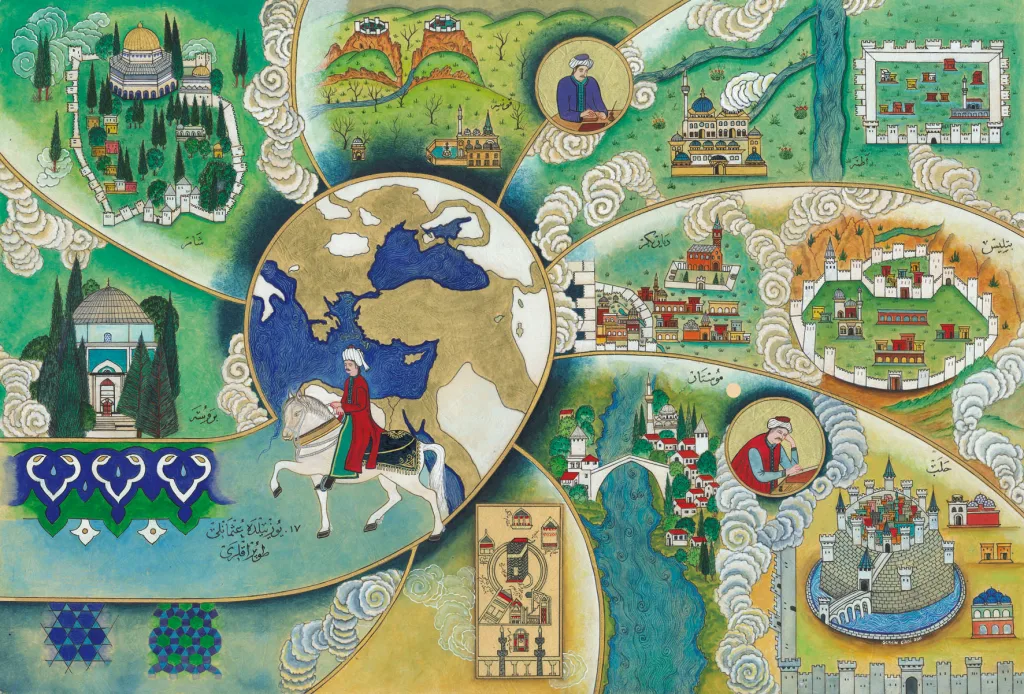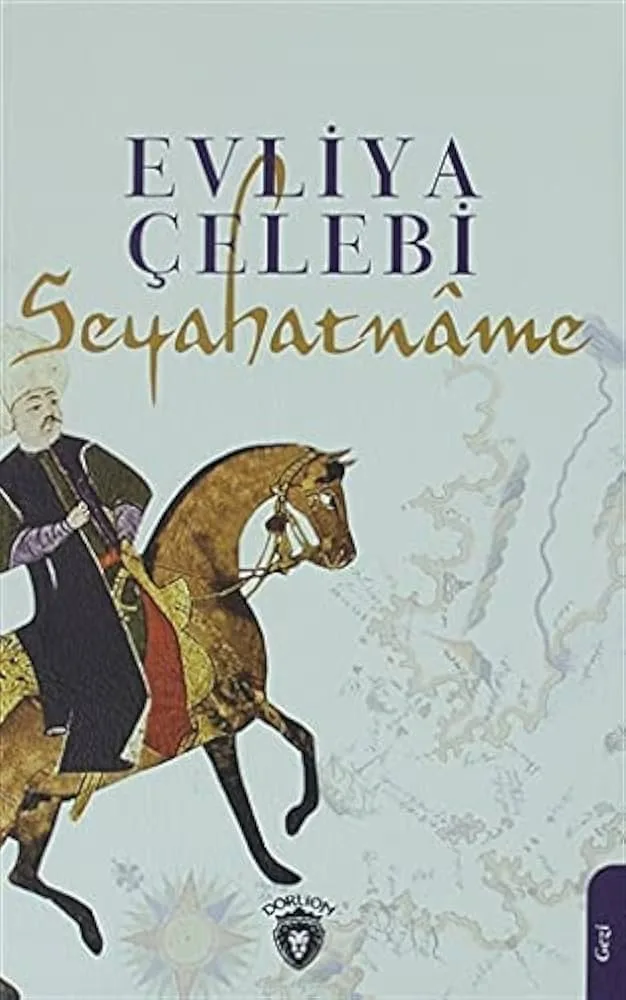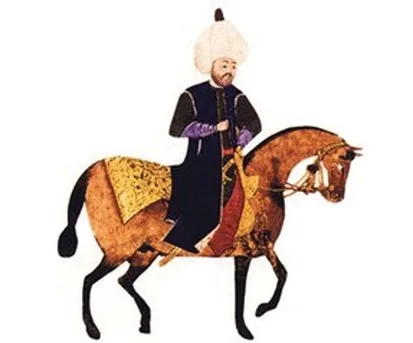Evliya Çelebi, the greatest traveler in Turkish and world history and the author of the greatest travel book, was born in Istanbul on March 25, 1611. His ancestors were from Kütahya, and his father was Derviş Mehmed Zıllî Efendi, the head jeweler of the Imperial Palace (Saray-ı Âmire). His mother was of Abkhaz origin and related to Grand Vizier Melek Ahmed Pasha, who would later become one of his close friends. In his works, Evliya Çelebi mentions that his grandfathers trace their lineage back to Hoca Ahmed Yesevi, the great saint of the Turks.
Education and Language Skills
Due to his father’s influence in the palace and connections with prominent figures of the time, Evliya Çelebi received a high-quality education. He studied for seven years at the Şeyhülislam Hamid Efendi Madrasa, took lessons from Müderris Ahfeş Efendi, and received music training from Derviş Ömer Efendi, becoming highly knowledgeable in music. He also studied at Sa’dîzade Dârülkurra and became a hafiz (Quran reader). Upon the order of Sultan Murad IV, he entered the palace, where he stayed for two years, continuing his education with lessons in calligraphy and music.
In addition to this rich education, he learned Arabic and Persian, the prominent foreign languages of his time. He also learned Greek from Simyon, a neighboring jeweler of his father, and took some lessons in Latin.

Personal Life and Character
Evliya Çelebi never married and lived his entire life as a bachelor. In his own words, he was a “çelebi” who constantly shaved, never growing a beard or mustache.
Evliya Çelebi’s Lifelong Passion for Travel
His passion for traveling led him to use every possible reason to wander, and he spent his entire life traveling. As he repeatedly states in his Seyahatname (Book of Travels), he wandered through the lands of the Rum, Arabs, Persians, Swedes, Poles, and Czechs, covering seven climates and the realms of eighteen sovereigns over a period of fifty-one years. Throughout his travels, he collected words from 147 different languages. An online map showing the cities he visited can be visited here.
In addition to his 10-volume Seyahatname, whose original manuscript is approximately 4,000 pages and kept at the Topkapı Palace Museum Library, he also mentions a work titled “Şakaname,” though no copies of this work have survived. Everything we know about Evliya Çelebi’s life is from his own accounts. Throughout his 51-year journey, he took continuous notes, meticulously recording where he went, what he did, and whom he met. His exact date and place of death remain uncertain, but it is believed that he died in Egypt sometime after 1685, where he had withdrawn into solitude.
The Seyahatname: Evliya Çelebi’s Book of Travels
The first eight volumes of Evliya Çelebi’s Seyahatname, housed in the Topkapı Palace Museum Library, are believed to be in his own handwriting. The 1st and 2nd volumes are located in the Baghdad Pavilion, catalogued as number 304, comprising 374 folios. The 3rd and 4th volumes, catalogued as number 305, contain 408 folios. The 5th volume, number 307, has 187 folios. The 7th and 8th volumes, number 308, contain 383 folios, and the 6th volume, stored in the Revan Pavilion under number 1457, includes 188 folios. Unfortunately, the 9th and 10th volumes are missing from this series. It is known that after Evliya Çelebi’s death, these two volumes, which were brought from Egypt to Istanbul, were in poor condition.
Preservation of the Original Manuscript
Three handwritten copies were produced by calligraphers of the time. One complete copy is preserved in the Pertev Pasha Section of the Süleymaniye Library, another in the Hacı Beşir Ağa Section of the Süleymaniye Library, and the third in the Baghdad and Revan Pavilions of the Topkapı Palace Museum Library. A single volume also exists in Istanbul University Library.
Handwritten Copies and Archival Records
The original manuscript was written in rik’a script on polished paper. The pages of each volume are carefully formatted and regular, usually containing 36 lines per page, with some reaching 40 lines. Up to the 5th volume, the manuscript was written meticulously, with proper punctuation and neat letter extensions. Where Evliya Çelebi wanted clarity or emphasis, he added diacritical marks. He paid attention to local pronunciations by marking certain words accordingly. However, from the 5th volume onward, the quality of writing declined, with missing extensions and diacritical marks, suggesting that Evliya, then in old age, had less time or energy to focus on careful transcription.
Publication History of the Seyahatname
Until introduced to the scholarly world by the famous historian Joseph von Hammer, the Seyahatname remained hidden in libraries. The first selections, titled Müntehabat-ı Evliya Çelebi, were published in 1843. A full-text publication was initiated in 1896 by historian and İkdam newspaper owner Ahmed Cevdet, covering the first six volumes until 1900. Volumes 7 and 8 were prepared by Kilisli Rifat (Kardam) and published in 1928 by the Turkish Historical Society. Volumes 9 and 10 were published by the Ministry of Education in 1935 and 1938, respectively.
Unfortunately, these early editions were censored and incomplete: certain parts were omitted, words altered, and some passages misread. Since both domestic and foreign editions relied on this flawed version, numerous errors proliferated.

Modern Editions and Translations
Exactly one hundred years after its first publication began in 1896, the Seyahatname received its first serious modern edition. Based on the presumed autograph copy kept in the Baghdad Pavilion of the Topkapı Palace Museum Library, the first volume was prepared by Orhan Şaik Gökyay and published by Yapı Kredi Publications in 1996. Subsequently, Seyit Ali Kahraman and Yücel Dağlı continued publishing the remaining volumes. Zekeriya Kurşun contributed to volume 2, İbrahim Sezgin to volume 5, and Robert Dankoff joined the project for volumes 7 through 10 and the republished first volume. The entire ten-volume series was completed in 2007.
To make the work accessible to modern readers, Seyit Ali Kahraman and Yücel Dağlı published a simplified Turkish version starting in 2003, completing the series in 2011. In 2010, Seyit Ali Kahraman also published a selection from the Seyahatname, representing the entire work.
Translations of Evliya Çelebi’s Seyahatname have appeared in English, Serbian, Hungarian, Greek, Romanian, Armenian, and various other languages. Unfortunately, many of these translations are based on the flawed first edition and contain significant omissions.
The Writing Process of the Seyahatname
Evliya Çelebi worked on his Seyahatname over several decades. He frequently revisited his earlier notes, revising and expanding them based on fresh memories or newly gathered accounts. Throughout his life, he maintained detailed diaries, often taking notes during his travels and later organizing them into fuller narratives. His meticulousness in early volumes contrasts with the hurried, less polished writing style seen in later volumes, suggesting age-related fatigue or diminished resources.

Evliya Çelebi’s Storytelling Style and Audience
Interestingly, Evliya sometimes incorporated local oral histories, legends, and even his own interpretations alongside factual reporting, blurring the lines between historical record and travel literature. He also acknowledged this mixing of sources, often qualifying uncertain statements and admitting where he relied on hearsay.
It’s evident that Evliya wrote primarily for an audience in Istanbul’s literary circles, embedding his text with witty observations, poetry, and references that appealed to Ottoman elites. The presence of takrir sections—official-style reports intended for court audiences—shows he also envisioned the Seyahatname serving as a form of bureaucratic record.
From a structural perspective, each volume corresponds roughly to a distinct phase of his life and geographical exploration. However, overlaps exist, and chronology isn’t strictly observed. Evliya’s storytelling prioritized thematic or regional coherence over strict sequentiality.
Volume-by-Volume Content Summary
Volume I: Istanbul and Evliya’s Early Life
Covers Istanbul in remarkable detail—its architecture, neighborhoods, customs, and socio-political life. Also includes Evliya’s personal background and early life. This volume is essentially a portrait of the imperial city.
Volume II: Anatolia, Thrace, and the Balkans
Focuses on his travels through Anatolia, parts of Thrace, and the Balkans. Describes towns, rural areas, and the varying dialects, food cultures, and trade practices across regions.
Volume III: Crimea and the Black Sea Coast
Details his journeys through Crimea and the Black Sea coast, including accounts of the Crimean Tatars. Includes naval observations and port descriptions.
Volume IV: Circassia, the Caucasus, Georgia, and Iran
Centers on travels in Circassia, the Caucasus, Georgia, and Iran. Contains extensive descriptions of Shirvan, Tbilisi, and Persian territories, including local customs, military structures, and religious practices.
Volume V: Persia, Eastern Anatolia, and Kurdish Regions
Continues with Persia, Eastern Anatolia, and Kurdish regions. Evliya comments extensively on local governance, trade routes, and cultural peculiarities.
Volume VI: Baghdad, Iraq, and Syria
Covers Baghdad, Iraq, and surrounding regions, as well as parts of Syria. Rich in architectural and urban descriptions. Includes narratives about significant battles and diplomatic missions.
Volume VII: Arabia and the Hajj
Focuses on the Arabian Peninsula, including Medina and Mecca, with unique insights into Hajj rituals and local religious life.
Volume VIII: Egypt, Nubia, and Sudan
Covers Egypt, Nubia, and Sudan. Includes detailed observations of Cairo’s urban life, the Nile’s significance, and sub-Saharan trade networks.
Volume IX: North Africa and the Return Journey
Primarily deals with North Africa, particularly Tripoli, Tunis, and Algeria. Also includes reflections on his return journey and scattered memories.
Volume X: Final Accounts and Appendices
More fragmented in structure, including additional accounts from the Balkans, reflections on the Ottoman court, and appendices summarizing various anecdotes and stories not included in earlier volumes.

